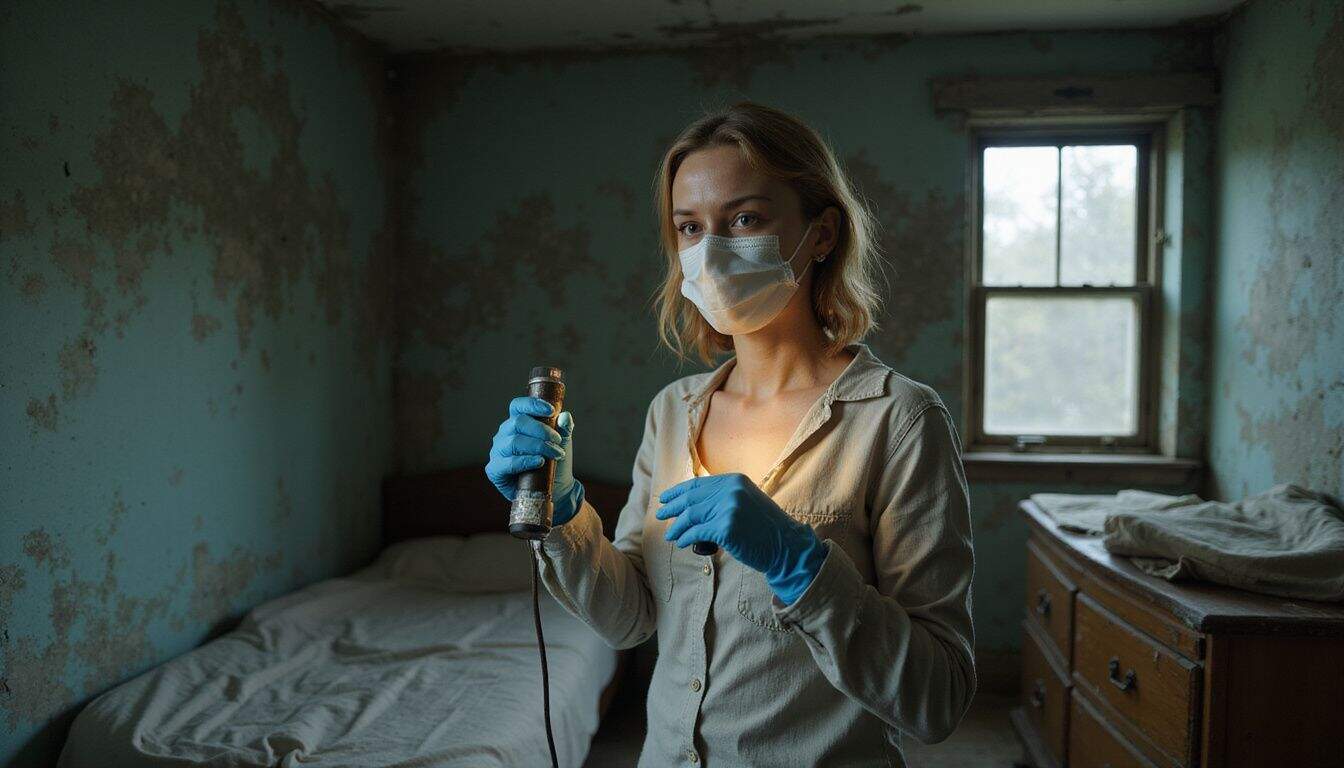Wake up stuffy, or smell something earthy at night? A moldy bedroom may be the cause. Mold thrives where air is damp, and it can trigger allergic reactions and sleep problems. This guide shows how to spot early signs, prevent moisture build up, and remove indoor mold safely.
Use these steps to protect your sleep and health today.
Key Takeaways
Bedroom mold often comes from excess moisture, poor ventilation, or leaks. Humidity above 50 percent and any water damage raise risk, according to public health and industrial hygiene guidance.
Exposure may trigger allergic reactions, worsen asthma, and irritate the lungs. Children and adults with asthma are more vulnerable.
Prevention starts with humidity control. Keep levels below 50 percent, fix leaks fast, ventilate rooms, and clean with safe products like white vinegar.
Look for black or green spots, peeling paint, and musty odors. Mold often hides behind furniture, under carpets, or inside closets.
As homes get tighter for energy savings, expect stronger air quality guidelines for rentals. Better humidity control will be a top priority.
Table of Contents
What is Mold in the Bedroom?
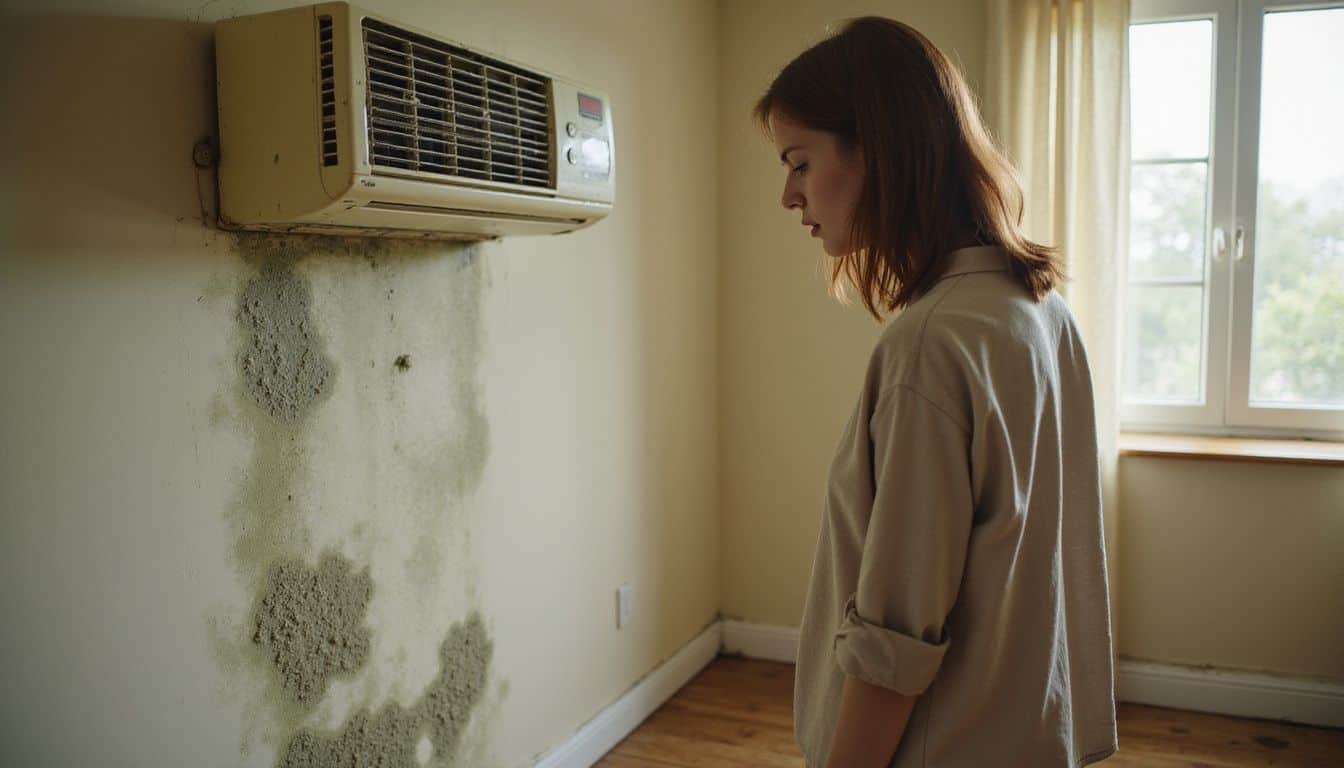
Mold in a bedroom often looks like tiny spots on walls or ceilings. It can also grow on the back of dressers or headboards. Indoor molds, including Stachybotrys chartarum, need moisture to live. Without water, they stop growing.
Mold spores are the seed-like particles molds release. Spores float in indoor air and land on damp surfaces. Even clean rooms have some spores in the air.
Many women notice a musty odor before seeing spots. Growth often appears near water damage or around window air conditioners. After moving into an older unit with poor airflow, I found fuzzy green patches behind my nightstand. Condensation formed there each morning.
Porous materials, like mattresses, rugs, and wood furniture, soak up water. If humidity control fails, mold growth can be rapid.
See patchy fuzz or smell a sour, earthy scent? Act quickly before a small issue becomes a costly fix.
Need an expert check? Consider a local inspection, such as a mold inspection in Huntsville, AL, to uncover hidden sources fast.
How Does Mold Develop in the Bedroom?

Mold starts where moisture lingers. Water sits on walls, ceilings, floors, or rugs, then spores settle and grow. Rooms with poor ventilation trap damp air, which speeds up growth. Leaks and spills feed hidden mold behind baseboards and under furniture.
What Causes Moisture and Humidity in Bedrooms?
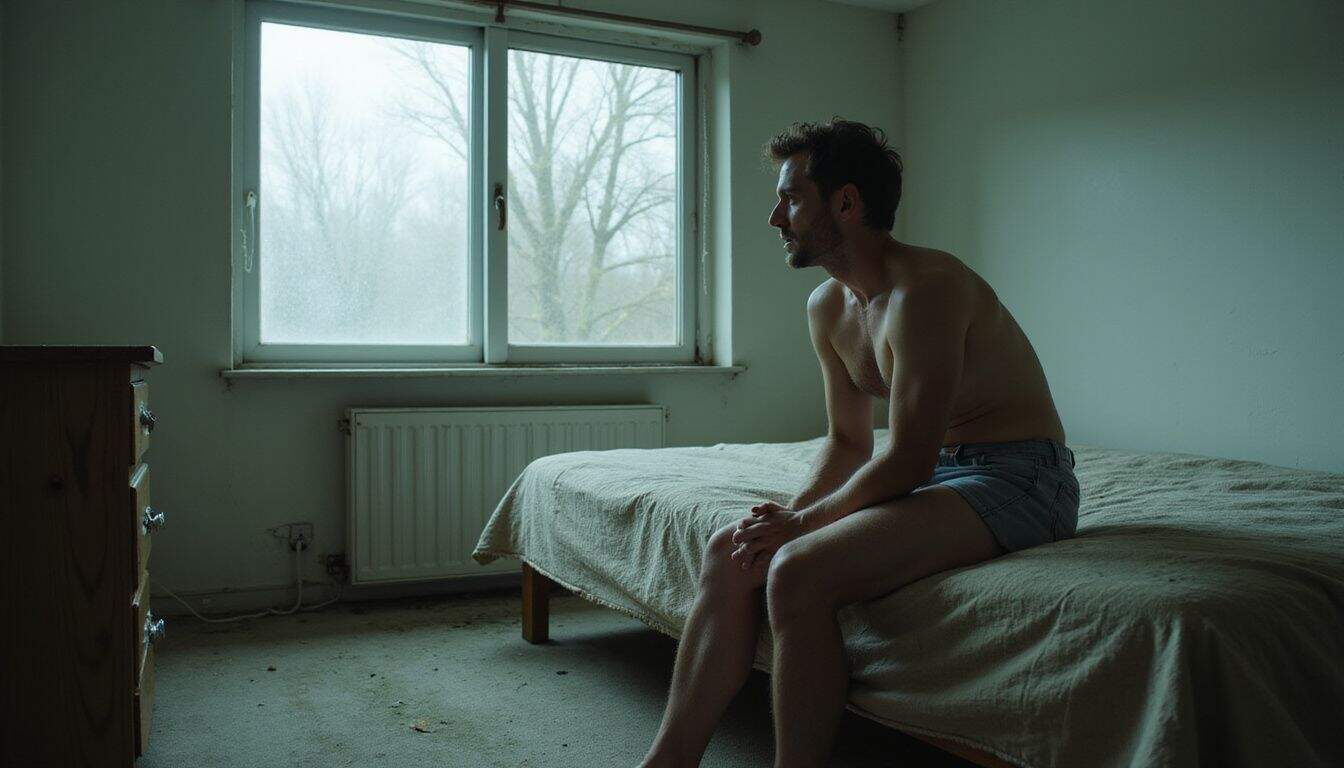
Sleeping people release water vapor as they breathe and sweat. Each person can add one to two pints of moisture per night. Closed doors and windows trap that moisture for hours.
Bathrooms connected to bedrooms can raise humidity. Without a strong ventilation system or exhaust fan, steam lingers. Wet laundry drying indoors and clothes dryers venting inside add more moisture. Hidden plumbing leaks also play a part.
Cool surfaces cause condensation when warm air hits them. You will see foggy windows, damp walls, or ceiling stains. Without airflow from open windows, HVAC systems, or dehumidifiers, moisture stays trapped.
Spills left wet for more than 48 hours raise mold risk. Humidity over 50 percent helps black mold spread on porous materials like carpeting, mattresses, and curtains.
Up next, see how poor ventilation and daily condensation create a perfect setup for mold.
How Do Poor Ventilation and Condensation Contribute to Mold?
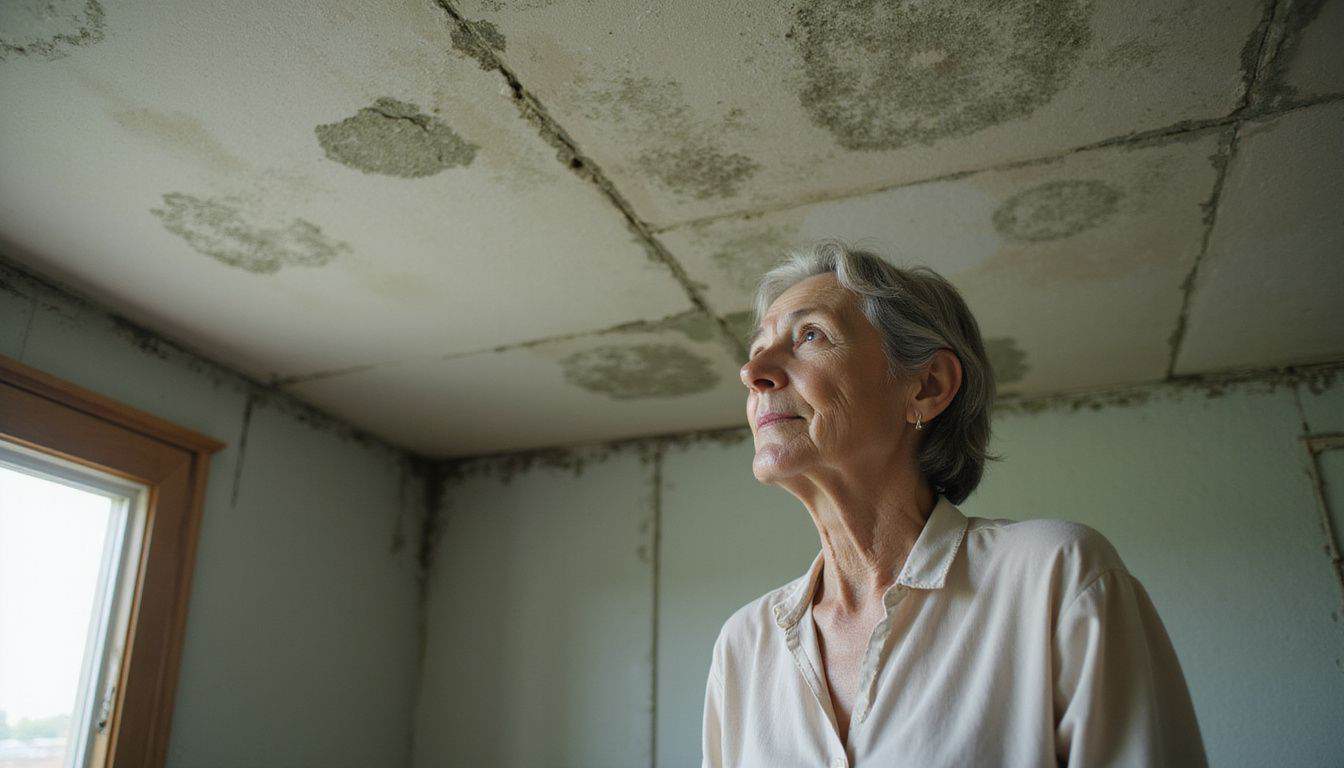
Poor ventilation traps humid air in your bedroom. High humidity creates moist surfaces that mold spores love. Condensation forms on windows and in tight closets when damp air cannot escape.
These wet spots become launch pads for hidden mold. Using air conditioning or opening a window improves airflow. Better airflow reduces humidity and limits condensation.
Daily routines, like showering or drying clothes inside, add more moisture. Without ventilation, humidity can climb above 60 percent, a risky range for mold growth. Industrial hygienists at the American Conference of Governmental Industrial Hygienists warn about that zone.
Long-term dampness can trigger breathing problems such as coughing or shortness of breath. Some fungi also produce toxins, including aflatoxin B1. Early detection helps protect your health and sleep quality.
Next, learn the common signs of a hidden infestation.
What Are the Signs of Mold in a Bedroom?
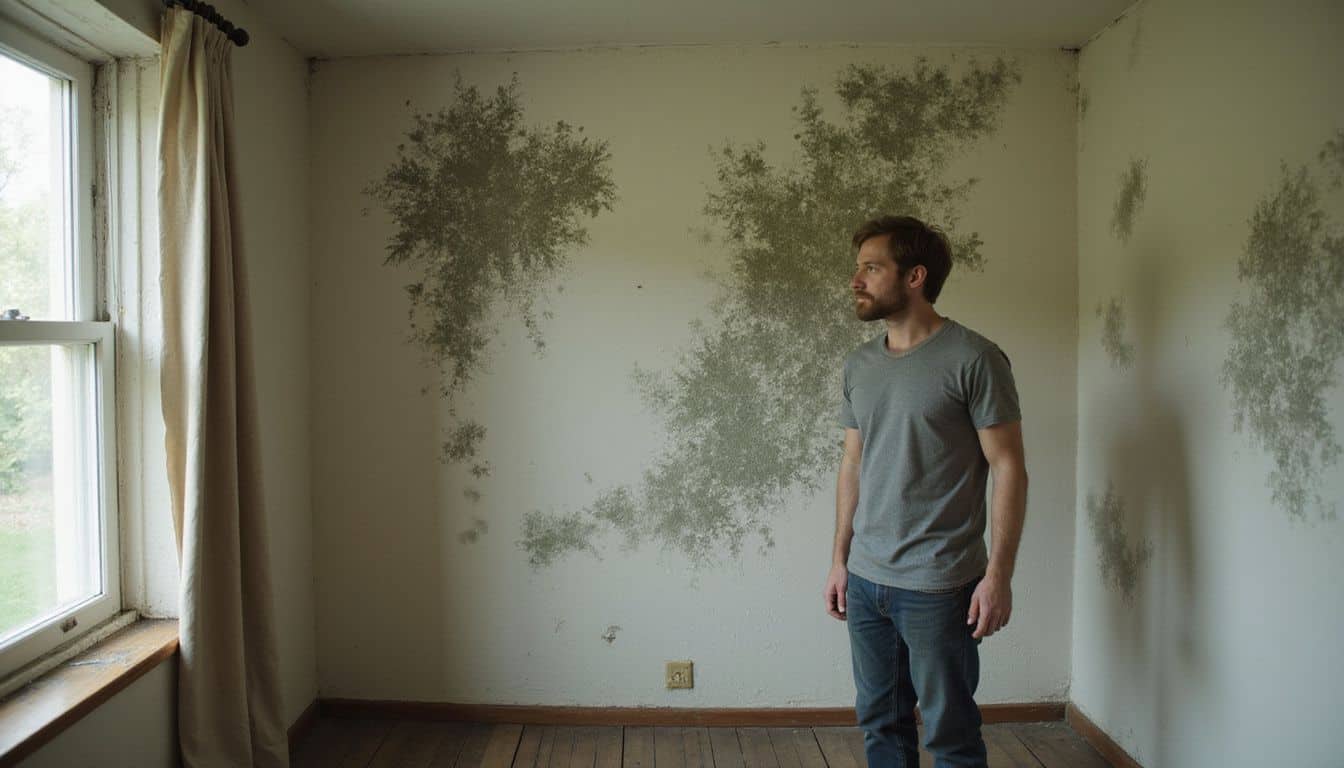
Mold often shows as green, gray, or black specks on walls or ceilings. It can also stain wood furniture and window frames. A musty odor may signal hidden growth behind rugs or inside air ducts.
How to Identify Visible Mold on Walls, Ceilings, or Furniture
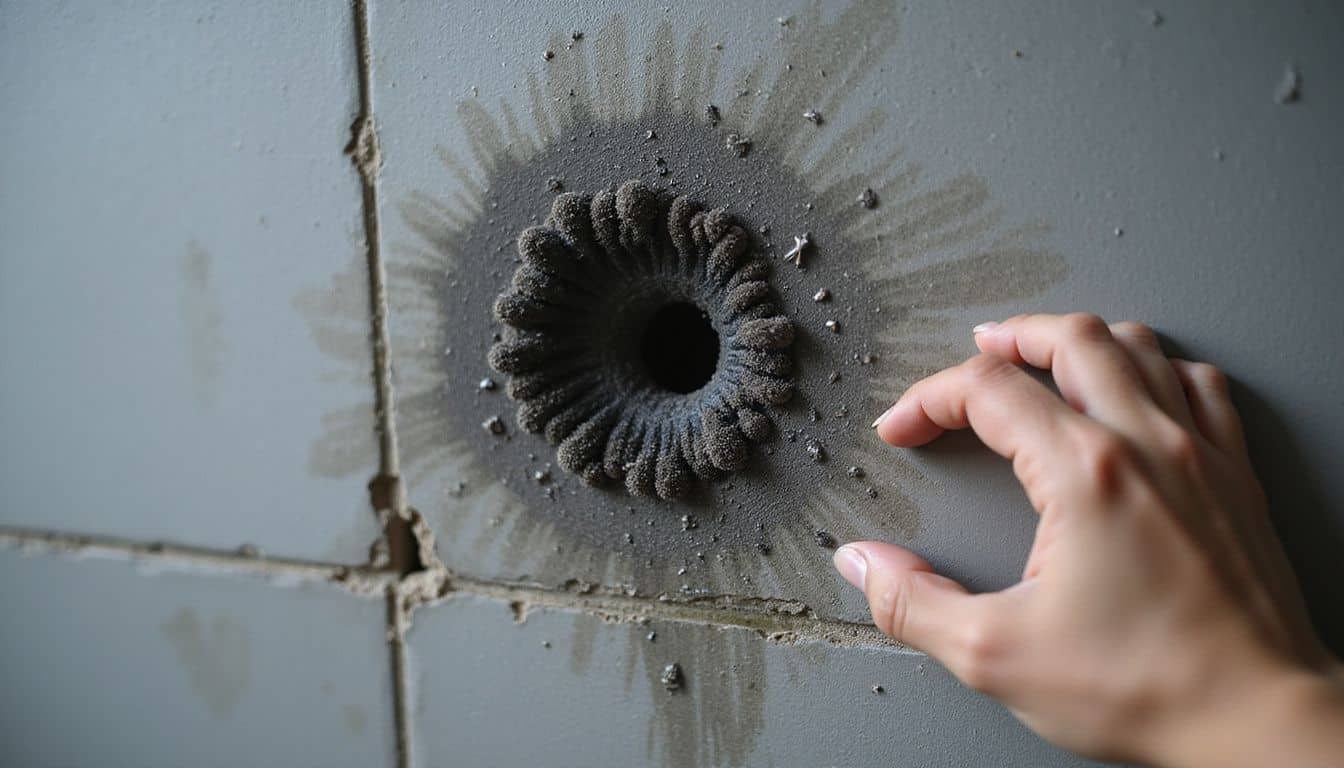
Look for spots that seem fuzzy, powdery, slimy, or leathery. Colors range from white and gray to brown, yellow, or black. Spots grow larger as colonies spread across porous materials like fabric or wood.
Check high moisture zones, especially near bathrooms and windows. Mold often starts where leaks or condensation appear. Natural materials, like wood and cotton, show spores sooner than hard plastics.
Regular checks catch visible mold early, which keeps you healthier.
Next, read what odors can reveal about hidden growth.
What Does a Musty or Unpleasant Odor Indicate?

A musty odor is often the first clue. Most molds release gases called MVOCs, or microbial volatile organic compounds. These gases smell earthy or sour, even before you see growth.
A lingering odor in a bedroom suggests spores nearby. The source may be carpet padding, mattresses, curtains, or damp closets. After a rainy week, I smelled dampness under my bed. Black dots were hiding near a small leak I had missed.
If you smell something earthy with no clear source, investigate. Moisture can sit behind wallpaper or inside walls. Ventilation and moisture control are key. Air purifiers help with particles, but they do not fix an active moisture problem.
How Can Mold Cause Allergy or Respiratory Symptoms?

Mold releases tiny spores into the air. When inhaled, the immune system treats them like invaders. This can cause allergic reactions and respiratory symptoms.
Common signs include sneezing, runny nose, and nasal congestion. You may also feel throat irritation, itchy eyes, a skin rash, or a chronic cough. People with asthma may notice more flare ups.
Research from the National Institutes of Health links early mold exposure with higher asthma risk in children. Those with weakened immune systems face extra risk, including lung infections.
Next up: What Are the Health Risks of Mold in the Bedroom?
What Are the Health Risks of Mold in the Bedroom?

Mold spores can lower indoor air quality. Symptoms may disturb sleep and quality of life. Knowing the risks helps you act sooner.
What Allergic Reactions Can Mold Trigger?

Coughing, sneezing, a runny nose, and itchy eyes are common. Some people get dry skin or red eyes. Those with family allergies or asthma often react more strongly.
Your immune system misreads tiny spores from black mold or mildew. The body makes antibodies and releases chemicals. That chain reaction causes symptoms.
Humid rooms and poor ventilation can make reactions worse. Sinus pressure and headaches can follow. If asthma is present, symptoms may get louder at night.
Species like Aspergillus and Cladosporium can inflame the sinuses. Keep moisture low with humidity control and quick leak repairs.
Even small amounts of household mold can bother allergy-prone people, according to industrial hygiene guidance.
How Does Mold Affect Respiratory Health?

Breathing in spores can irritate the respiratory tract. People may cough, wheeze, or feel shortness of breath. Strong odors can also irritate the nose and throat.
The Institute of Medicine and the World Health Organization link damp homes to asthma and bronchitis. Some estimates suggest a large share of current asthma cases relate to indoor dampness and mold exposure.
Women with asthma or COPD often notice worse nights in damp rooms. Children exposed to musty odors may have higher asthma risk. Skin issues like eczema can also flare from ongoing contact.
Thorough cleaning and mold remediation help reduce these threats. If symptoms are severe, talk with a healthcare provider.
Can Mold Suppress the Immune System?

For some people, yes. Breathing spores may strain the immune system, especially if immunity is already weak. People receiving cancer treatment or living with autoimmune disease face higher risk.
Certain molds produce toxins that add stress to the body. Babies exposed during the first year may face higher odds of asthma later. Poor sleep from odors and irritation can also chip away at immune health.
I struggled with frequent sinus infections until I found black spots behind my bed. Moisture control and routine rug cleaning improved my health and comfort.
Are There Neurological Effects from Mold Exposure?
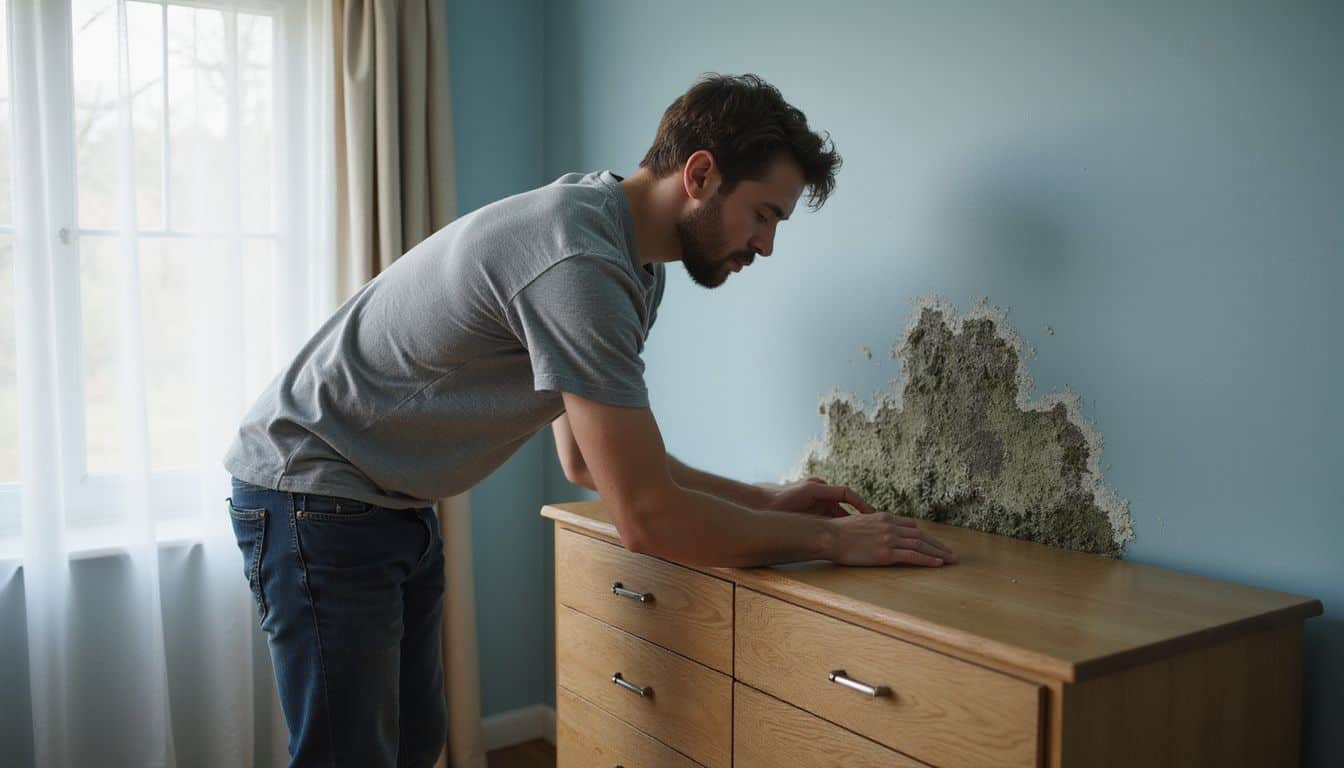
Some reports suggest long-term exposure may affect thinking or focus. Certain molds make mycotoxins, which can inflame brain tissue in lab studies. Not everyone will react this way.
Large studies do not show a direct link to dementia. Still, sensitive people may feel brain fog or short term memory lapses. I felt foggy until we removed hidden patches behind our furniture.
Testing for mycotoxins in people is not reliable today. If cognitive symptoms appear, improve air quality and talk with a clinician.
How to Prevent Mold in the Bedroom

Prevention starts with moisture control. Watch humidity, fix leaks fast, and keep air moving. A simple humidity meter, also called a hygrometer, can guide daily choices.
How to Maintain Proper Humidity Levels
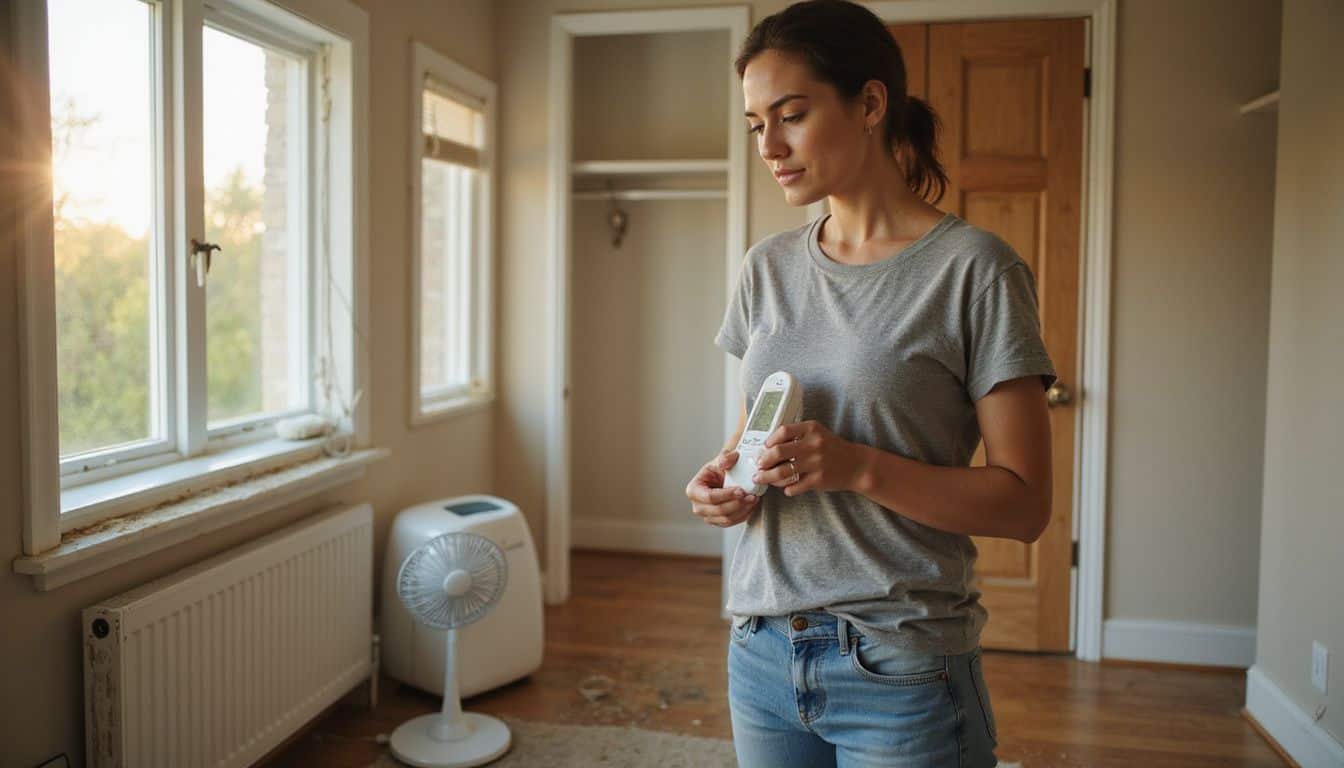
Keeping proper humidity in range helps prevent mold. Bedrooms feel fresher and allergy symptoms often ease.
- Use a digital humidity meter every day. Aim for 30 to 50 percent.
- Run a dehumidifier in warm or wet months if levels rise above 50 percent.
- Open windows when weather allows. Use fans or vents to boost airflow.
- Fix leaks from roofs, windows, plumbing, or AC units quickly.
- Dry spills on carpets, furniture, and floors within 24 hours.
- Dry laundry outside the bedroom. Indoor drying raises humidity and irritation.
- Use exhaust fans near kitchens and bathrooms that affect the bedroom.
- Limit indoor plants in sleeping spaces. Damp soil adds moisture.
- Dust corners, closets, and behind furniture so surfaces can dry faster.
- Check windowsills and under carpets monthly for water stains.
These habits keep moisture in check and lower allergic reactions from common indoor molds.
How to Improve Bedroom Ventilation
A strong moisture control plan helps. Good ventilation makes it even better by flushing damp air outside.
- Open windows for 5 to 10 minutes daily to refresh air.
- Install an exhaust fan with a timer to remove humid air.
- Place humidity monitors near beds, and keep readings below 60 percent.
- Use portable fans to push damp air out after showers or storms.
- Clean vents and grills so dust does not block airflow.
- Run HVAC or central fans on low at night to circulate dry air.
- Add door draft stoppers to limit steamy air from bathrooms.
- Swap heavy curtains for lighter ones in summer to reduce condensation.
- Use simple timer switches for exhaust fans to build a steady routine.
These steps keep air moving year round, which slows mold growth.
Why Regular Cleaning and Decluttering Helps Prevent Mold
Regular cleaning and decluttering reduce places where moisture can hide. Dust and clutter trap water and feed spores.
- Declutter so fewer porous materials, like old clothes or boxes, hold moisture.
- Cleaning removes dust that can keep dampness on surfaces.
- Dry leaks and spills within 24 to 48 hours to stop colonies from forming.
- Fewer items improve airflow, which lowers humidity.
- A tidy room reveals early signs like odors or spots sooner.
- Do not leave damp laundry or food waste. Both attract allergens.
- Clear space near windows, under beds, and behind dressers to spot issues fast.
- Many women sleep better in clean rooms with fresher air.
- Use safe disinfectants approved by workplace safety agencies like OSHA for surface cleaning.
- For high clutter situations, read how to clean a hoarder’s house for mold prevention for extra help.
How to Inspect and Fix Leaks Quickly
Leak checks are vital. Quick fixes prevent water damage and future mold.
- Look for stains on walls, ceilings, and windows after rain or showers. These may be hidden leaks and raise the risk of mold spores.
- Feel floors near radiators, AC units, or pipes for damp areas.
- Listen for drip sounds behind walls or under sinks late at night.
- Inspect under sinks and around tubs weekly for soft wood or peeling paint.
- Use a flashlight to check dark corners for moisture or a musty odor.
- Fix dripping faucets or loose connections right away.
- Dry wet bedding, carpets, and other porous items within 24 to 48 hours.
- Check the water meter overnight with taps off. Unexpected changes can signal a leak.
- Act fast on every sign. A quick response saves money and prevents big repairs.
- If you see visible black mold, wear household rubber gloves and an N95 respirator during cleanup.
I once spotted a small ceiling stain from a roof vent. A quick patch stopped the odor and protected my sleep.
Should You Limit Indoor Plants to Prevent Mold?
Plants can improve a bedroom, but they also add moisture. Too many pots or overwatering can push humidity above 50 percent.
Check soil weekly for soggy spots and fungus. Water less, or move some plants out of the bedroom. Sensitive people who notice odors may need fewer plants.
Use a hygrometer to track humidity, and aim for under 50 percent. A dehumidifier can help during sticky months.
How to Remove Mold from the Bedroom
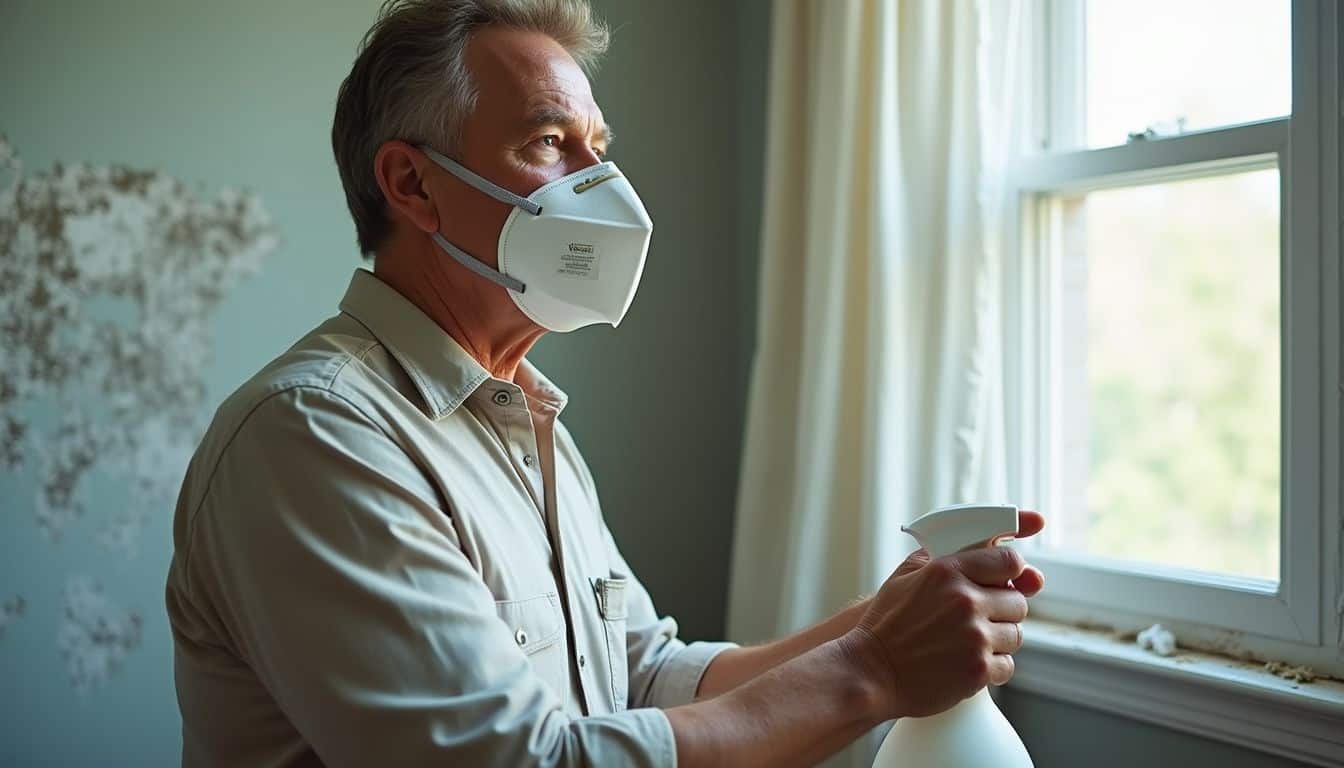
Proper mold removal protects your sleep and eases allergy risks. Wear an N95 respirator, ventilate the space, and use safe cleaning products. If an area is large, hire a pro.
How to Clean Visible Mold Safely
Mold on surfaces can affect health and comfort. Use careful steps to remove visible mold and limit exposure.
- Wear protective gear, including gloves, goggles, and an N95 respirator.
- Scrub hard surfaces with detergent and warm water. Dry them fully.
- Discard absorbent or porous materials, like ceiling tiles or carpet, if they are moldy.
- Repair any plumbing leaks first so growth does not return.
- Open windows or use fans to improve ventilation during cleaning.
- Clean up to 10 square feet yourself. Call a professional for larger areas.
- Avoid chlorine bleach on porous items. It may not reach deep spores.
A new musty odor or fresh stains may mean more hidden growth. Inspect nearby areas to be sure.
What Mold-Killing Products Are Effective?
Plain white vinegar works well on many hard surfaces. Spray, wait, scrub, and dry. For stubborn stains, a bleach-based cleaner can help on nonporous walls.
For long term control, consider a commercial mold control spray. These products help prevent regrowth on cleaned areas. Let the surface dry for at least 24 hours.
Any treatment works best with steady humidity control. Fix the moisture source, or the mold will return.
What Safety Precautions Should You Take During Cleanup?
Wear protective gloves made of vinyl, nitrile, or rubber. Do not touch colonies with bare skin. Goggles protect eyes from dust and spores.
Use a NIOSH approved N95 respirator so you do not inhale spores. Keep doors or windows open for airflow. If using bleach, mix no more than one cup per gallon of water. Never mix bleach with ammonia or other cleaners.
If you have allergies, asthma, or a weak immune system, avoid cleanup. Hire trained help instead. People with breathing issues should not stay in the home during heavy removal.
Safety note, this information is educational, not medical advice. If symptoms worsen, seek medical care.
Do Air Purifiers and Dehumidifiers Help Control Mold?
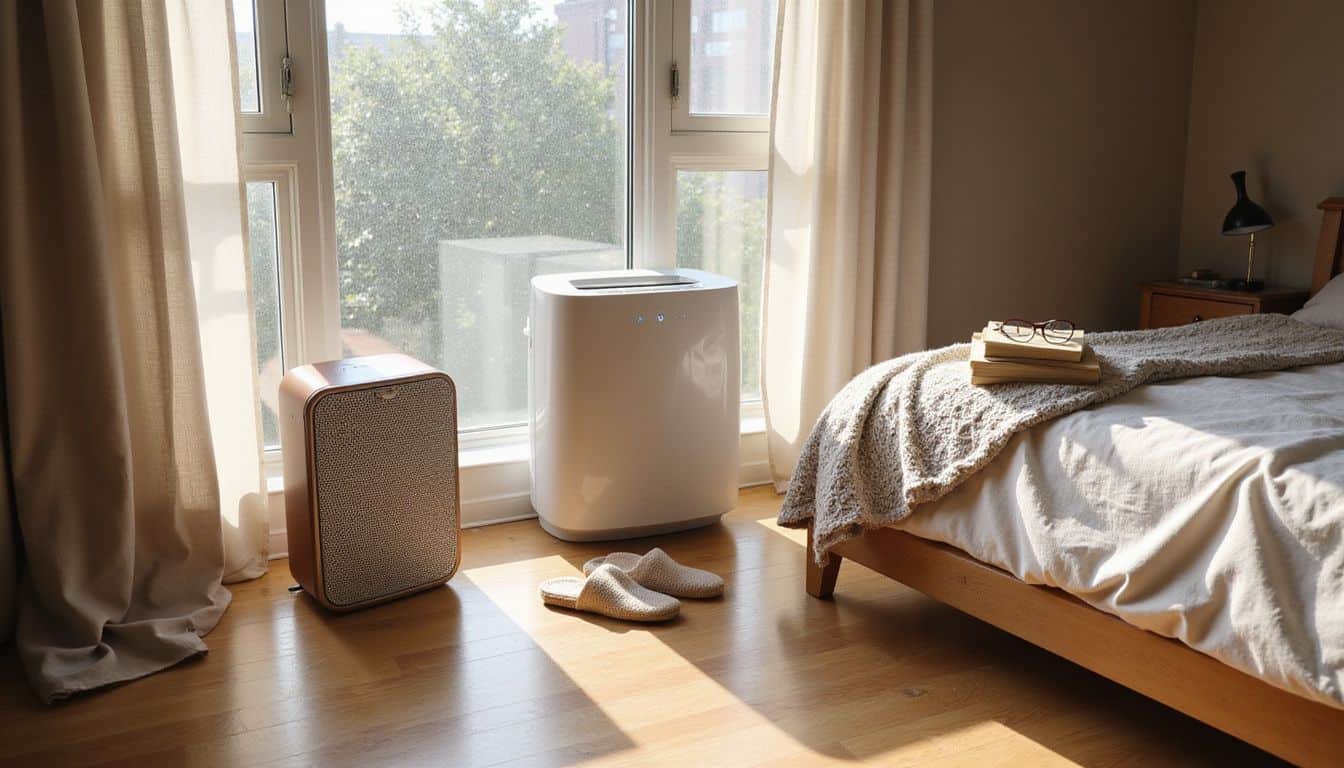
Yes. Dehumidifiers lower humidity and slow spores from spreading. Keep the room between 30 and 50 percent.
I noticed fewer odors after setting my dehumidifier within that range. Air purifiers with HEPA filters trap airborne mold spores and dust.
Use both in damp homes or after leaks. Empty the dehumidifier often so water does not sit. Sensitive lungs often feel relief when these devices run daily.
Should You Test for Mold in the Bedroom?
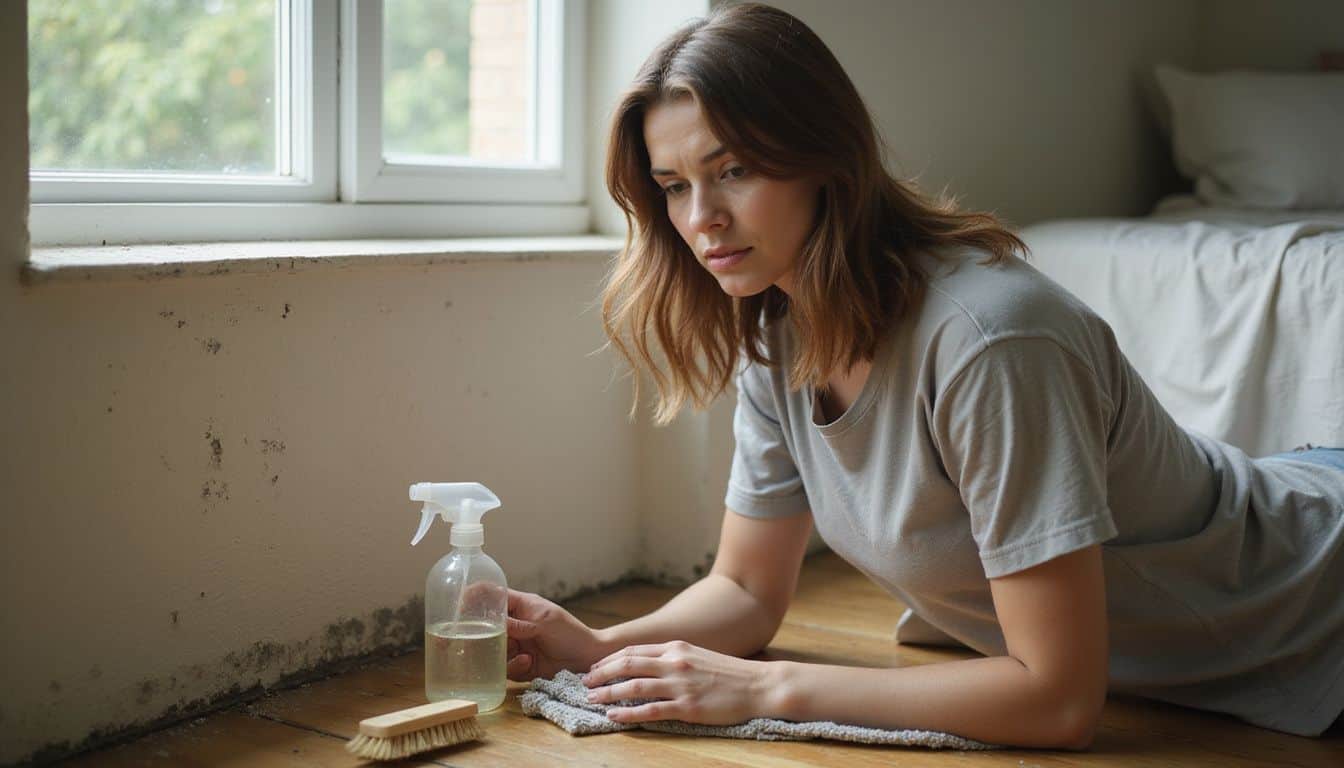
Most homes do not need testing unless there are clear clues. Examples include a musty odor, unexplained health problems, or signs of water damage. There are no federal standards for indoor mold levels, so test results can confuse people.
Store kits often lack context. If you see spots or smell dampness, focus on cleanup and moisture control first. Surface sampling can confirm if cleanup worked, but it should be done by experienced pros.
In my home, fixing leaks and using a hygrometer helped more than any kit. Dehumidifiers and air purifiers reduced leftover spores and freshened the air.
How Will Mold in the Bedroom Change in 2025?
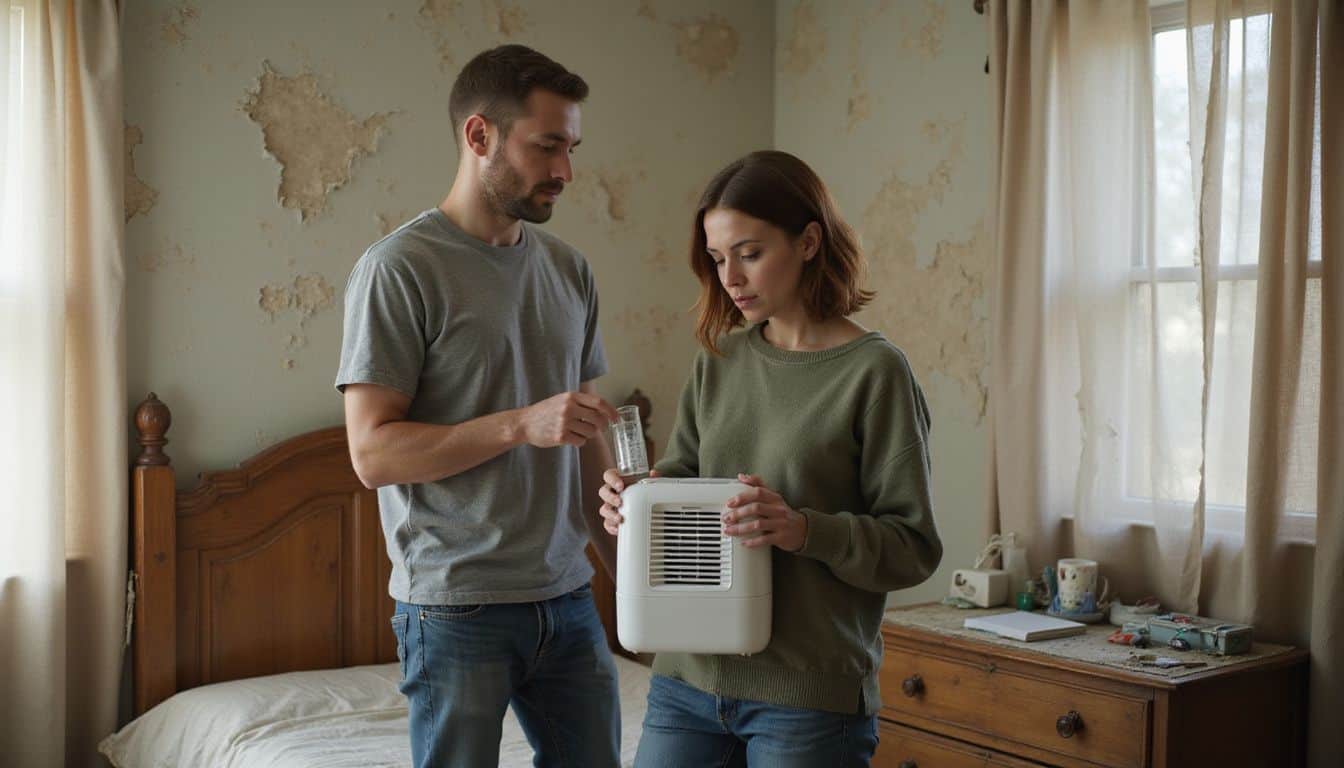
Experts expect more mold issues as homes become tighter and hold moisture. Poor airflow and higher humidity raise the odds of black mold or hidden mold after leaks.
The American Conference of Governmental Industrial Hygienists plans updates that stress moisture control and humidity targets. More people will use HEPA air purifiers and smart dehumidifiers with sensors.
Property managers may face quicker response rules for leaks. Tenants could see better reporting and documentation. I once had a landlord delay a ceiling repair. Green stains spread behind my headboard, and morning sneezes began within weeks.
New cleaning agents may claim to control spores without harming soft materials like mattresses. As awareness grows about sleep quality and toxins, expect more targeted services for bedrooms.
People Also Ask
What health risks can mold growth in a bedroom cause?
Mold spores from hidden or visible colonies may trigger allergic reactions and asthma. Some people worry about mold toxicity. Black mold concerns many because certain strains make toxins that may affect breathing and gut balance. Seek medical advice for ongoing symptoms.
How do poor ventilation and water leaks contribute to mold problems?
Poor ventilation traps moisture, and leaks raise humidity. Both create ideal conditions for mold growth on porous materials like drywall and carpet. Without humidity control, a musty odor often signals an active problem.
What are the best ways to prevent bedroom mold?
Start with moisture control. Fix leaks fast, use dehumidifiers, and improve airflow. Clean surfaces so spores cannot settle and spread.
How should I safely remove black mold from my sleeping space?
Wear an N95 respirator that fits well, plus gloves and goggles. Use products made for mold removal, and ventilate the room. For large areas or heavy damage, hire certified pros who follow industry guidelines.
When should I call experts for help with bedroom fungi issues?
Call professionals if the affected area is larger than 10 square feet. Also call if odors persist, if colonies keep returning, or if you suspect hidden mold behind walls. Pros use containment and filtration to avoid spreading spores.
References
https://www.sleepfoundation.org/bedroom-environment/mold-in-the-bedroom
https://www.bustmold.com/resources/about-mold/how-to-prevent-mold/prevent-mold-in-bedroom/ (2018-08-21)
https://www.health.ny.gov/publications/7287/
https://www.cdc.gov/mold-health/about/index.html (2024-09-26)
https://my.clevelandclinic.org/health/diseases/22309-mold-allergy
https://www.mayoclinic.org/diseases-conditions/mold-allergy/symptoms-causes/syc-20351519
https://pmc.ncbi.nlm.nih.gov/articles/PMC4667360/
https://www.alzdiscovery.org/cognitive-vitality/blog/can-mold-harm-your-brain (2020-05-21)
https://pmc.ncbi.nlm.nih.gov/articles/PMC7231651/
https://www.webmd.com/lung/mold-mildew (2024-10-27)
https://www.epa.gov/mold/mold-cleanup-your-home (2025-06-18)
https://www.youtube.com/watch?v=HZRJdIjjiVU
https://www.cdc.gov/mold-health/about/clean-up.html (2024-02-16)
https://thedryair.com/blogs/news/whats-better-for-mold-air-purifiers-or-dehumidifiers (2024-05-30)
https://www.epa.gov/mold/brief-guide-mold-moisture-and-your-home (2025-03-27)
